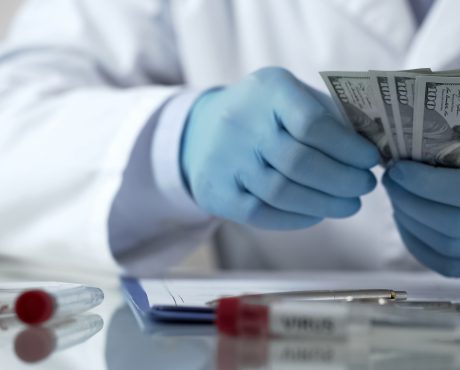A Top Dividend Stock From an Unlikely Industry
Income investors are not fans of uncertainty, which is part of the reason they don’t look at biotech stocks that often.
With some biotech companies, their stock’s appeal depends critically on the results of certain clinical trials. If you are a long-term income investor, you probably don’t want to be kept up at night by unpredictability like that.
Plus, biotech firms have to pour big money into research and development. So even if they are making good money, they don’t always have the resources to set up a regular dividend policy.
The good news is, there are exceptions.
Gilead Sciences, Inc. (NASDAQ:GILD) is one of those exceptions. Despite what I just pointed out about its industry, this biopharmaceutical company could be a great fit for an income investment portfolio.
Why Income Investors Should Consider Gilead Sciences, Inc.
Headquartered in Foster City, California, Gilead Sciences is one of the bigger players in the biotech business. It commands around $85.0 billion of market capitalization and has a presence in more than 35 countries on six continents.
Today, the company focuses on four primary therapeutic areas: HIV, liver disease, oncology, and inflammation.
The No. 1 reason for income investors to consider GILD stock is that the company offers a growing stream of dividends.
Earlier this month, the board of directors of Gilead Sciences, Inc. declared a quarterly dividend rate of $0.63 per share, starting with the first quarter of 2019. This represented a 10.5% increase from its previous payment of $0.57 per share. The newly declared dividend will be paid on March 28 to shareholders of record as of March 15. (Source: “Gilead Sciences Announces 11 Percent Increase in First Quarter 2019 Dividend,” Gilead Sciences, Inc., February 4, 2019.)
In this day and age, a double-digit dividend hike is quite impressive, especially when you consider the fact that Gilead comes from an sector that’s not really known for paying dividends.
Looking further back, you’ll see that since the company set up a quarterly dividend policy in 2015, management has raised the payout every single year, at a compound annual growth rate of 10%. (Source: “Gilead Sciences, Inc. Dividend Date & History,” Nasdaq, last accessed February 14, 2019.)
A Safe and Growing Payout
For those wondering whether Gilead’s payout is safe after those sizable dividend hikes, a look at the company’s financials should be reassuring.
In the fourth quarter of 2018, Gilead Sciences generated adjusted earnings of $1.44 per share. That amount easily covered its quarterly dividend payment of $0.57 per share. (Source: “Gilead Sciences Announces Fourth Quarter and Full Year 2018 Financial Results,” Gilead Sciences, Inc., February 4, 2019.)
In full-year 2018, the company earned an adjusted net income of $6.67 per share while paying out $2.28 per share in total dividends. That translated to a payout ratio of just 34.2%, leaving a wide margin of safety.
On the cash flow front, things looked pretty solid as well. Gilead Sciences, Inc. generated $8.4 billion in operating cash flow last year. Its cash dividends, on the other hand, totaled just $3.0 billion for the year.
And thanks to its solid business, Gilead has built up quite a sizable pile of cash over the years.
How big is that cash pile? Well, as of December 31, 2018, the company’s cash, cash equivalents, and marketable debt securities totaled $31.5 billion.
For a company with a market cap of around $85.0 billion, $31.5 billion is indeed a huge amount of cash.
What this means is that Gilead Sciences has plenty of resources to invest in new and existing drug pipelines, which could boost its sales and profits down the road.
At the same time, if management wants to increase the company’s shareholder return, a large cash pile will give them plenty of room to do so.
Speaking of shareholder return, note that paying an increasing dividend is not the only way that Gilead Sciences returns cash to investors. The company has also been buying back its own stock.
In 2018, Gilead spent $2.9 billion repurchasing 39.7 million of its own shares. This move reduced the total number of shares outstanding, allowing each existing shareholder to own a slightly larger portion of the company. (Source: “Q4 2018 Earnings Results,” Gilead Sciences, Inc., February 4, 2019.)
Stock Down, Yield Up
Yet despite delivering oversized shareholder returns, GILD stock hasn’t been a hot commodity. Over the past 12 months, shares of this biotech stock have tumbled more than 19%.
The neat thing is, because dividend yield moves inversely to a company’s share price, the downturn in GILD stock has pushed its yield up. And the recent dividend hike made the deal even sweeter.
Trading at $65.92 apiece at the time of this writing, Gilead stock now offers an annual dividend yield of 3.8%. That’s nearly double the payout of the average S&P 500 company. (Source: “S&P 500 Dividend Yield,” Multpl.com, last accessed February 14, 2019.)
For investors who want to earn a secure income stream from the volatile biotech industry, Gilead Sciences, Inc. deserves a serious look.
